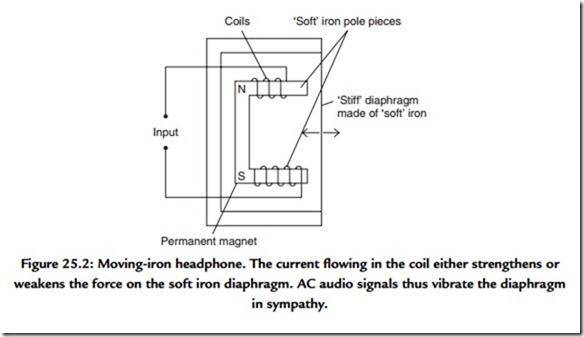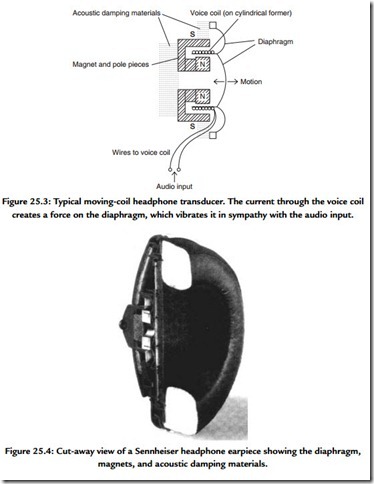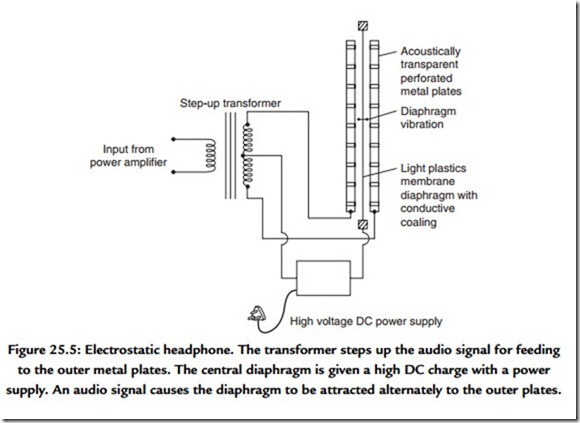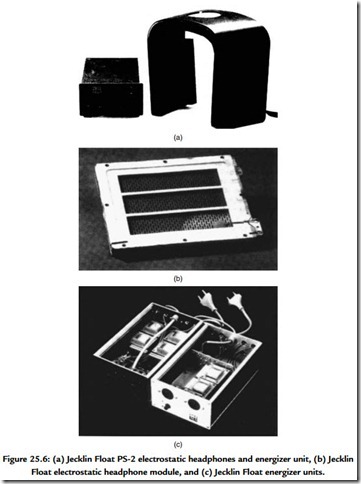Headphone Types
Moving Iron
Early headphones relied on many turns of very fine wire wound on to a magnetic yoke held close to a stiff disc made of a “soft” magnetic alloy such as Stalloy (Figure 25.2). A permanent magnet pulled the thin disc toward the yoke with a constant force and audio signals fed to the coil caused this force to vary in sympathy with the input. They were very sensitive, needing hardly any power to drive them, and were very poor in sound quality due to the high mass and stiffness of the diaphragm, which caused major resonances and colorations—not to mention distortions due to magnetic nonlinearities.
Currently used in telephone receivers, they are not found today in any application requiring high-quality sound. That is reserved for other more advanced techniques.
Moving Coil
Moving-coil headphones (Figure 25.3) work in exactly the same way as moving-coil loudspeakers. A coil of wire, suspended in a radial magnetic field in an annular magnetic gap, is connected to a small radiating cone.
When an alternating audio signal is applied to the coil, the coil vibrates axially in sympathy with the signal, recreating an analogue of the original wave shape. The cone converts this into corresponding fluctuations in air pressure, which are perceived as sound by the listener’s nearby ears. Figure 25.4 shows a cut-away view of a Sennheiser unit.
The major difference, of course, between moving-coil headphones and loudspeakers is that the former are much smaller, with lighter and more responsive diaphragms. They can consequently sound much more open and detailed than loudspeakers using the moving-coil principle. They are usually also much more sensitive, which can mean that, in addition to reproducing detail in the signal that is inaudible through loudspeakers, they can also reproduce any background noise more clearly, particularly power amplifier hiss,
which is not reduced when the volume is turned down. This is not peculiar to moving-coil headphones and can occur with any sensitive headphone.
Moving-coil headphones are essentially medium- to low-impedance devices with impedances between eight and a few hundred ohms. They are usually operated via the normal amplifier headphone socket, which simply takes the loudspeaker signal and diverts it through a resistor network to reduce it to a level more suitable for the high sensitivity of the headphones. Alternatively, some high-quality amplifiers provide a separate amplifier to drive the headphones directly.
Many cassette decks also provide a headphone outlet, and some headphones of lower than average sensitivity sometimes do not work very well in this situation due to the limited output available.
Electrodynamics Orthodynamic
This type of headphone is essentially in the same family as the moving-coil type, except that the coil has, in effect, been unwound and fixed to a thin, light, plastics diaphragm.
The annular magnetic gap has been replaced by opposing bar magnets, which cause the magnetic field to be squashed more or less parallel to the diaphragm. The “coil” is in fact now a thin conductor zig-zagging or spiraling its way across the surface of the diaphragm, oriented at right angles to the magnetic field so that sending a constant direct current through the conductor results in a more or less equal unidirectional force, which displaces the diaphragm from its rest position. An alternating music signal therefore causes the diaphragm to vibrate in sympathy with it, creating a sound-wave analogue of the music.
The great advantage of the electrodynamic, or flat diaphragm type of headphone, is that the conductor moves the air almost directly, without requiring a cone to carry the vibrations from a coil at one point, to the air at another, with the very real risk of introducing colorations, break-up, distortion, and uneven frequency response.
Unlike a cone, the film diaphragm does not have to be very stiff, although it is sometimes pleated to give it a little more rigidity because the force on it is not entirely uniform. As a result, it can be very thin and light, which results in a lack of stored energy and a very great reduction of the other problems inherent in cones as outlined earlier.
Consequently, good headphones of this type tend to sound more like electrostatics, with an openness and naturalness that eludes even the best moving-coil types.
Electrodynamic headphones tend not to be quite so sensitive as their moving-coil counterparts and are often best used at the output of amplifiers, rather than with cassette decks. Impedance is usually medium to low and is almost entirely resistive.
Electrostatic
The electrostatic headphone, like the electrodynamic, uses a thin plastics diaphragm, but instead of a copper track it requires only to be treated to make it very slightly conductive so that the surface can hold an electrostatic charge. It can consequently be very light.
The diaphragm (Figure 25.5) is stretched under low mechanical tension between two perforated conductive plates to which the audio signals are fed via a step-up transformer.
The central diaphragm is kept charged to a very high voltage with respect to the outer plates using a special type of power supply, capable of delivering only a nonlethal, low current, high voltage from the house mains, or, alternatively, by an energizer, which uses some of the audio signal to charge the diaphragm to a similarly high but safe voltage.
The diaphragm experiences electrostatic attraction toward both outer plates. The spacing between the plates and diaphragm, the voltage between them, and the tension on the
diaphragm are all chosen carefully so that the film does not collapse on to either plate. Instead it stays in a stable position between the outer plates, attracted to each one equally during no-signal conditions. When an audio signal is fed to the transformer, it is stepped up at the secondary from a few volts to around a thousand volts. This unbalances the forces on the diaphragm in sympathy with the audio signal, causing it to be attracted alternately to each plate and of course reproducing an analogue of the original sound.
The push–pull action of the transformer and plates effectively produces a linear force on the diaphragm regardless of its position between the plates—unlike normal single- ended electrostatic attraction, which follows an inverse square law and would create large amounts of distortion in a transducer.
The electrostatic headphone is therefore the most linear of all the types available and with its super-light diaphragm, weighing less than several millimeters of adjacent air, it is not surprising that good headphones of this type can offer superb quality sound—the best available. However, this essentially simple technique is the most complex to execute. Not surprisingly, electrostatic headphones are the most costly to manufacture and buy. Figure 25.6 shows details of the Jecklin Float PS-2 type.
They are generally less sensitive than moving-coil types and are usually operated directly from the amplifier’s loudspeaker terminals. Due to the capacitive nature of the electrostatic element and the complex inductive/capacitive nature of the transformer, they tend to have more reactive impedance than other types, but this does not usually pose any problem for good amplifiers. Air ionization between the diaphragm and the plates limits the maximum signal and polarizing voltages. Likewise, the signal voltage on the plates must not exceed the polarizing voltage. These factors impose limitations on the maximum sound pressure level that can be achieved.
Electrets
Basically, the electret headphone is an electrostatic type but using a material that permanently retains electrostatic charge—the electrostatic equivalent of a permanent magnet. The electret has the advantages of the conventional electrostatic, but does not require an additional external power supply. It is similarly restricted in maximum sound pressure level, although both types produce perfectly adequate sound pressure levels with conventional power amplifiers.
High Polymer
High polymer is basically a generic name to cover piezoelectric plastics films such as polyvinylidene fluoride film.
Piezo-electric materials have been known for many years. They change their dimensions when subjected to an electric field or, conversely generate a voltage when subjected to mechanical strain.
The ceramic barium titanate and crystals such as Rochelle salt and quartz are two materials that have been used for many years in devices such as crystal phono cartridges, ultrasonic transducers, and quartz oscillators but their stiffness is too high and mechanical loss too low for wide-frequency-range audio applications.
High polymer films, however, are very thin, some 8 to 300 μm, and have very low mechanical stiffness, which makes them ideal for transducer diaphragms. The basic film is made piezo electric by stretching it to up to four times its original length, depositing aluminum on each side for electrodes, and polarizing with a high DC electric field at 80–100ºC for about an hour.
When voltage is later applied across the film, it vibrates in a transverse direction, becoming alternately longer and shorter. If the material is shaped into an arc, this lengthening and shortening are translated into a pulsating movement, which will generate sound waves in sympathy with the electrical input signal.
It is a relatively simple matter to stretch the high polymer diaphragm across a piece of polyurethane foam pressing against a suspension board to create an arc-shaped diaphragm and make a very simple form of headphone.
High polymer transducers were first developed by Pioneer. Advantages are claimed to be a very low moving mass, similar to electrostatics but without the complexity, and, of course, no power supply. The high polymer headphone is also claimed to be much more sensitive than the electrostatic type and unaffected by humidity, which can reduce the sensitivity of electrostatics. Harmonic distortion is also said to be very low at under 1%.



